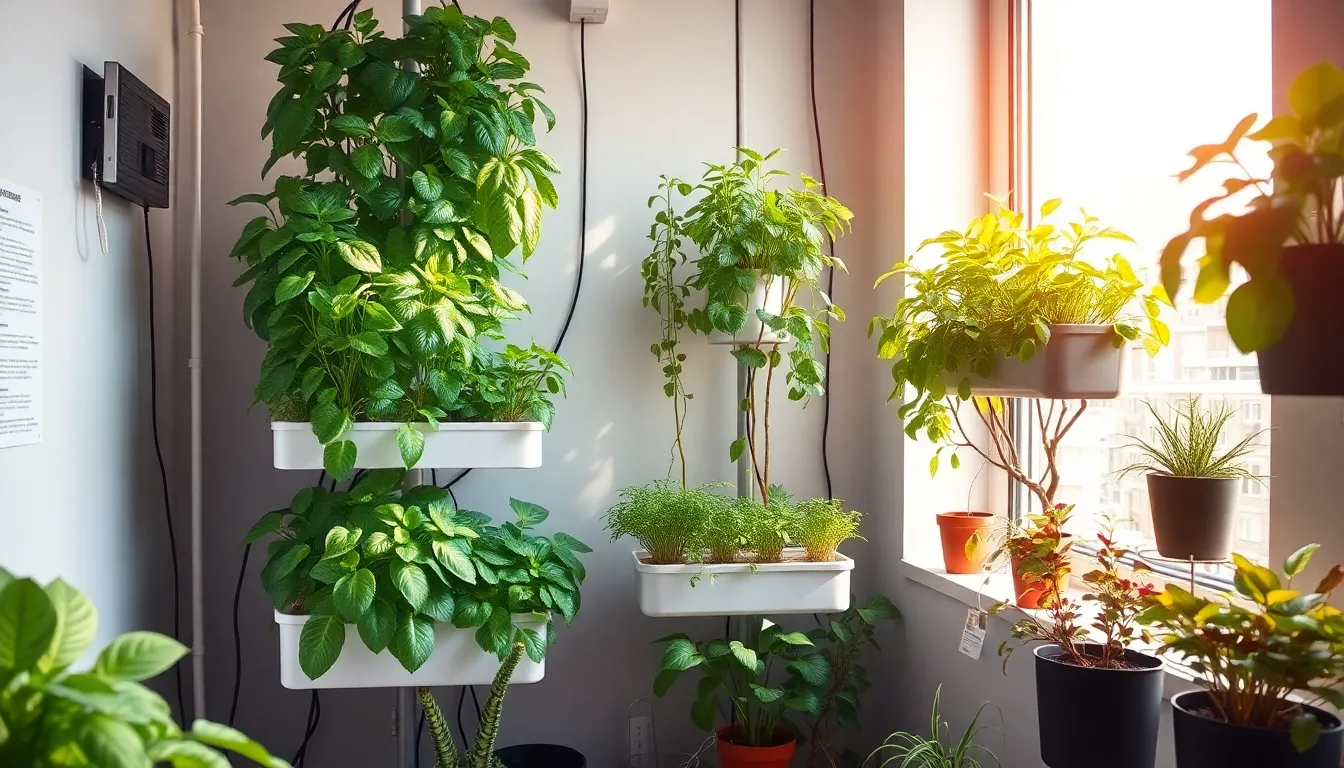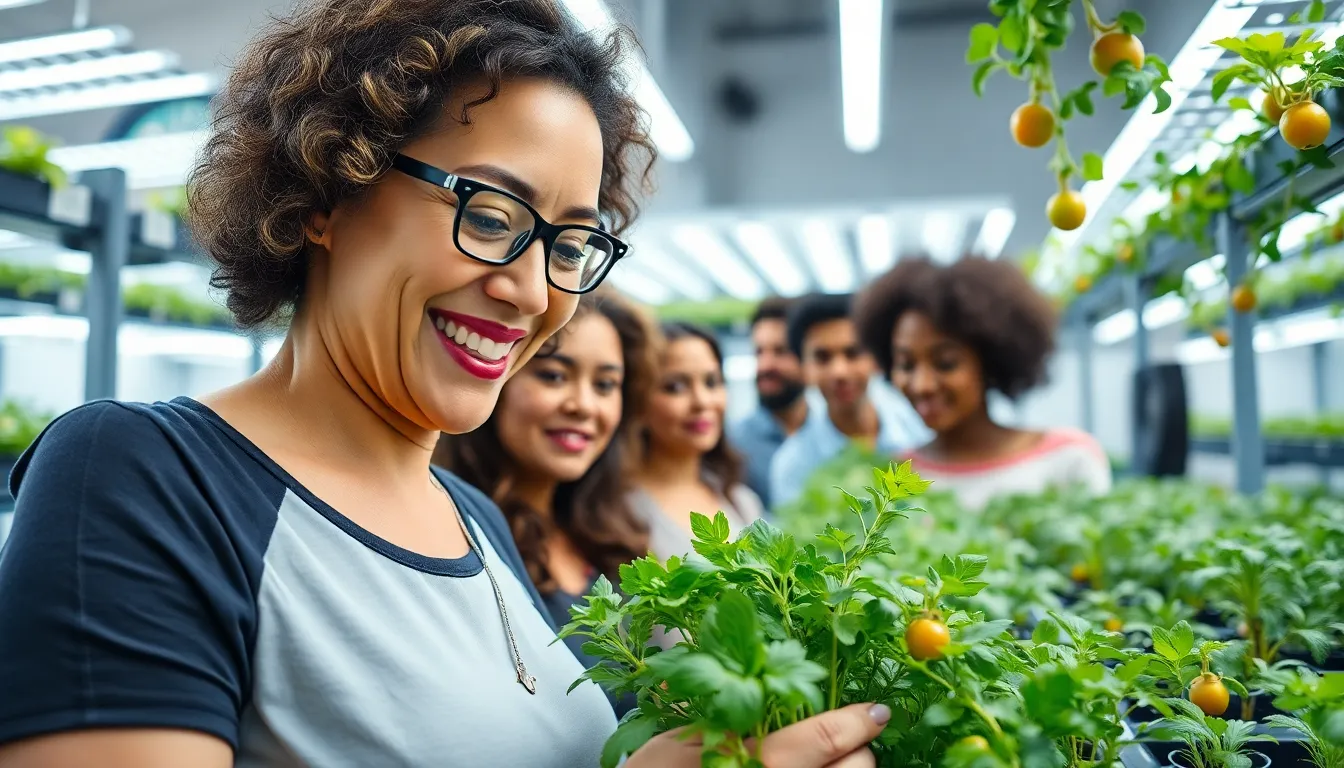Imagine growing fresh herbs and vegetables right in your living room without the dirt and mess of traditional gardening. Sounds like a dream, right? Welcome to the world of hydroponic gardening, where plants thrive in nutrient-rich water instead of soil. It’s the perfect solution for urban dwellers and green thumbs alike who want to enjoy homegrown produce without the fuss.
Table of Contents
ToggleOverview of Hydroponic Gardening
Hydroponic gardening involves growing plants without soil, utilizing nutrient-rich water solutions instead. This method caters to various types of plants, including herbs, leafy greens, and even fruits. By eliminating soil, growers reduce pests and diseases, leading to healthier plants.
Nutrient delivery in hydroponics allows for precise monitoring and adjustment. Growers can enhance growth rates, achieving faster yields compared to traditional gardening. Studies indicate that hydroponically grown plants can mature up to 30% faster than those grown in soil.
Environmental control plays a significant role in hydroponic systems. Factors such as light, temperature, and humidity are easily managed. Well-designed systems can optimize these conditions year-round, making it suitable for urban dwellings with limited outdoor space.
Various hydroponic systems exist, each with unique advantages. Nutrient Film Technique (NFT) circulates a thin film of nutrient solution over plant roots. Deep Water Culture (DWC) keeps roots submerged in a nutrient solution, providing direct access to water and oxygen. Aeroponics suspends plants in air, misting roots with nutrient solution for maximum exposure.
Sustainability becomes a crucial aspect of hydroponic gardening. Growers often report using up to 90% less water than traditional soil methods. This conservation aligns with global efforts to promote efficient resource usage in agriculture.
Considering the benefits, hydroponic gardening represents a viable solution for individuals seeking fresh produce. It also meets the growing demand for sustainable practices in food production. By adapting to hydroponic methods, urban gardeners can cultivate their own food while minimizing environmental impact.
Benefits of Hydroponic Gardening

Hydroponic gardening offers numerous advantages that make it an attractive choice for urban dwellers and gardening enthusiasts. Increased crop yield stands out as a primary benefit. Hydroponically grown plants experience quicker growth due to direct access to nutrients. Data shows plants can mature up to 30% faster than those cultivated in soil. Increased yields come from optimized nutrient delivery, allowing for larger and healthier crops.
Space efficiency is another compelling reason to adopt hydroponics. Indoor systems can fit into smaller areas, making them ideal for apartments and limited spaces. Vertical farming methods expand growing areas without requiring additional land. Growers can successfully cultivate various plants in compact environments, maximizing production in minimal space. Utilizing hydroponics enables individuals to grow more in less, contributing to a sustainable food source without the need for vast outdoor gardens.
Types of Hydroponic Systems
Various hydroponic systems cater to different needs and preferences. Each method offers distinct advantages for growers aiming to maximize efficiency and harvest quality.
Nutrient Film Technique (NFT)
Nutrient Film Technique utilizes a thin film of nutrient-rich water flowing over the plant roots. This method promotes excellent oxygen access and nutrient absorption. Plants grow in channels or narrow troughs, allowing roots to partially submerge in the solution. Regular monitoring ensures optimal nutrient concentration. This system is highly efficient, reducing water usage while enhancing growth rates. Plants can experience 25% faster development compared to traditional methods. NFT thrives in conditions where balance and flow remain consistent, making it ideal for leafy greens and herbs.
Deep Water Culture (DWC)
Deep Water Culture suspends plant roots directly in oxygenated nutrient solutions. This approach ensures abundant nutrient uptake, fostering rapid growth. Plants rest on a floating platform, with roots submerged in the nutrient-rich water below. Air pumps supply oxygen, preventing root suffocation. DWC systems are user-friendly, even for beginners, due to their simplicity and straightforward setup. Growers often see significant yield increases, particularly with fast-growing varieties. The method allows for quick adjustments to nutrient levels, maintaining plant health and vitality.
Essential Components for Success
Critical components ensure success in hydroponic gardening. Two essential elements include grow lights and nutrient solutions.
Grow Lights
Grow lights provide the necessary light spectrum for plant photosynthesis. They simulate sunlight, promoting healthy growth in indoor environments. LED grow lights benefit hydroponic systems with energy efficiency and low heat output. These lights emit wavelengths that enhance flowering and fruiting processes. Many growers prefer full-spectrum options for versatility across various plant types. Selecting the right intensity also influences growth rates. By adjusting the distance between plants and lights, gardeners control light exposure effectively. Ensuring proper light duration (typically 12 to 16 hours daily) supports optimal plant development.
Nutrient Solutions
Nutrient solutions supply essential elements for plant growth in hydroponic systems. These solutions contain macronutrients like nitrogen, phosphorus, and potassium, alongside micronutrients such as iron and calcium. Each nutrient plays a crucial role in plant health and yield. It’s vital to monitor nutrient concentration, adjusting levels based on plant growth stages. Growers often utilize pre-mixed solutions tailored specifically for hydroponics. Regular testing of the pH levels also maintains nutrient uptake efficiency. Balancing these factors contributes significantly to higher crop productivity and quality.
Challenges in Hydroponic Gardening
Hydroponic gardening offers numerous benefits, but challenges can hinder success. Understanding these hurdles is crucial for optimal plant growth.
Initial Setup Costs
Starting a hydroponic system involves significant expenses. Equipment such as grow lights, nutrient solutions, and reservoirs requires financial investment. For example, a complete hydroponic system can range from $100 for simple setups to $2,000 for advanced systems. Grow lights typically cost between $50 and $500 depending on the type and wattage. Additional costs for seeds, growing mediums, and monitoring equipment also accumulate. Long-term savings from reduced water usage and increased crop yield can offset initial expenses, but the upfront investment might deter some novice gardeners.
Knowledge and Maintenance
Successful hydroponic gardening demands knowledge and consistent maintenance. Understanding the specific needs of plants, such as light requirements and nutrient balance, is essential. It takes time to learn how to monitor pH levels and nutrient concentrations accurately. Regular system checks ensure that pumps and lights operate efficiently. Troubleshooting common issues, like root rot or nutrient deficiencies, requires familiarity with hydroponic principles. For those lacking experience, resources like online forums and local workshops can provide valuable guidance, helping to navigate the complexities of hydroponic systems effectively.
Hydroponic gardening offers an innovative and efficient way to grow fresh produce indoors. This method caters to urban dwellers and gardening enthusiasts seeking a sustainable solution for homegrown herbs and vegetables. By eliminating soil and utilizing nutrient-rich water, growers can enjoy healthier plants and faster growth rates.
The advantages of hydroponics extend beyond just increased yield. With precise control over environmental factors and reduced water usage, this gardening technique aligns with modern sustainability goals. While challenges exist in terms of initial investment and maintenance, the rewards of hydroponic gardening make it a compelling choice for anyone looking to enhance their indoor gardening experience. Embracing hydroponics can lead to a greener lifestyle and a bounty of fresh produce right at home.




